| |
"With his crinkly-soft eyes, his grandly equine nose, and the loping moose-like walk, he looks for all the world as though he had sprung full-blown from his own drawing board. When you see Theodor S. Geisel plain, all that seems to be missing is his signature below, two words warmly familiar to millions of children the world over and their grateful parents. The two words are – Dr. Seuss." |
| |
Saturday Evening Post 1977 Interview with Theodor S. Geisel* |
Mr. Geisel occupies a unique niche in American culture. In my own British childhood, his pseudonym was a passport to another world, a name that instantly summoned up a specific visual palette, and word play that was immediately recognisable. Even in The Sixth Sense, he's name-checked by Bruce Willis because of a particular class of word association, a style that is still singular to this day. I was never a Grinch fan. But while his Cat in the Hat imagery, looming large in infant school libraries, was not as soothing as most children's books from that era were, a spell was definitely exerted, his work a club to be joined... What really sold me on the great merit of his work was a short book for children published in 1990 (I was an immature twenty-nine year old at the time and didn't get to read the book until my late thirties). 'Oh, The Places You'll Go' was a children's book that did something utterly unprecedented in my own childhood reading experience. It told the truth. To children. It said that life could be extraordinary except when it wasn't... It makes me very sad that a song with this particular wisdom was dropped from Dr. Seuss's one and only live action movie. 'Oh, The Places You'll Go' laid the ground for those futures less dreamt of. It prepared a child for the inevitable periods to be spent in the doldrums – or as it was put in the book, 'The Waiting Place'. I was struck by the naked honesty of the narrative. Here was a book that was imparting real wisdom in an understandable and highly digestible way.
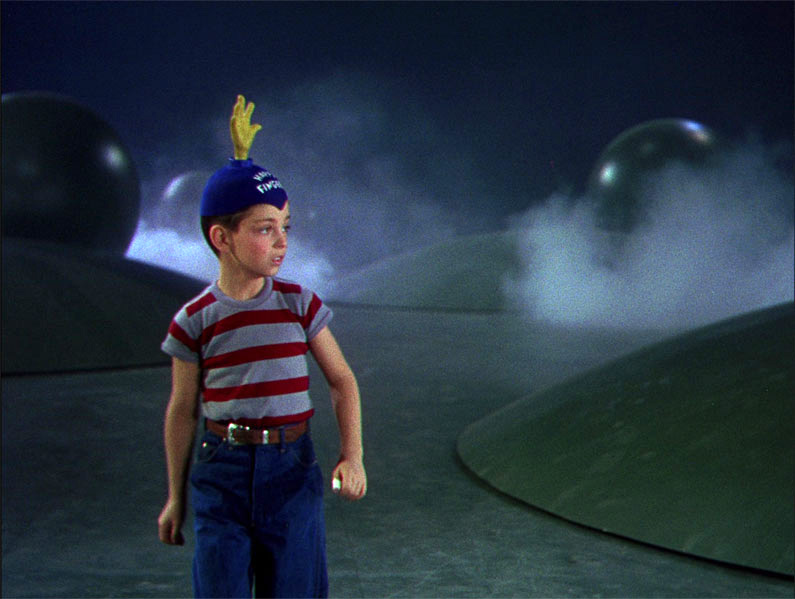
I'm blithely disregarding Hollywood's more recent attempts at capturing Dr. Seuss's singular, and literally fantastic worlds and in the style of the beloved author... I quite liked Horton Hears A Who so let's go back to '52. There will be no more of that, however tempting... The good Dr. Seuss came up with the story and co-wrote the screenplay with Allan Scott for The 5,000 Fingers of Dr. T. Its narrative is... uh... Well, if I describe it in blunt terms, it will come across as the ramblings of a man in a well-buckled piece of clothing. Here goes. A young, all-American boy does not enjoy piano lessons taught by Dr. Terwilliker. His mother is in the Doctor's thrall while the boy's only friend seems to be the plumber, Mr. August Zabladowski. Falling asleep at the piano keys, he enters a surrealistic otherworldly dream realm presided over by Dr. T. who wants to capture five hundred boys to play his many thousand keyed, giant piano. Forever. Ambitious soul, Dr. T. In the dream, he is to marry the boy's mother and his control over his own world is absolute and extraordinarily and hilariously fey. His guards look like middle-aged, overstuffed Thunderbird pilots (it's the costumes) and at the top of the security heap is a pair of male roller-skaters who share a long beard for reasons so beyond me, it's theoretical physics. In the dream the boy teams up with the plumber to thwart Dr. T's plans. Intrigued? Befuddled? Just a tad curious? And the World War II references are legion. But there is a very good temporal reason for that...
Let's get the several strange Simpsons coincidences out of the way. Theodor Seuss Geisel was born in a town called Springfield. The young boy bullied by Dr. Terwilliker is called Bart and Terwilliger is the surname of Bart Simpson's greatest enemy, Sideshow Bob (with the 'k' substituted for a 'g'). In fact Seuss's original Dr. T. was spelled with a 'g' and reverted to a 'k'. There's also a delightful musical number that's very close to the Mr. Burns parody of 'Be Our Guest' from Disney's Beauty and the Beast. I'm prepared to believe that the Sideshow Bob surname was inspired by the musical, as I'm fairly sure that each of the Simpsons was named after Matt Groening's own family. But it's a fascinating list of trivia. The glorious Technicolor process is especially kind to flights of outrageous fantasy and all praise to producer Stanley Kramer (yes, the Stanley Kramer) and director Roy Rowland for bringing to life one of the most extraordinary fantasies I have seen in a long while. Visually, it's akin to The Cabinet of Dr. Caligari designed by Alfred Junge (designer of Michael Powell's and Emeric Pressburger's A Matter of Life and Death) and William Cameron Menzies (designer of Invaders From Mars) assisted at the edges by Tim Burton. The opening shot could even be a practical outtake of Burton's red planet extravaganza. To give the movie its proper credit, the extraordinary sets and production design was the brain offspring of two men, production designer Rudolph Sternad and art director Cary Odell. Musically it has real madness in it, songs and dance routines but also a dream based orchestra with parodies of instruments played by green skinned men in ragged trousers. The visuals on display here in the dungeons have the amazing effect of pinching your entire face so it feels like your eyes have moved closer to your nose while your lips inch north. It's a puzzled face, a WTF face, as for a moment you try to make sense of what you're seeing and then accepting it just makes you marvel that someone, some time, somewhere chose to commit such images to Technicolor film. I mean, why are the players green?
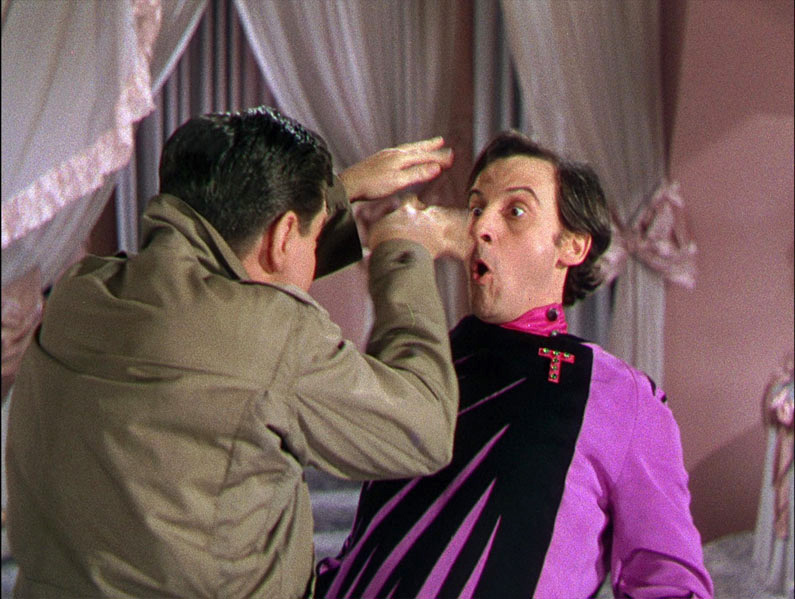
A lot has been written about the initial failure of the film to find an audience. When invited guests start walking out of a premiere, you know the picture's in trouble. Stanley Kramer, without director Rowland's participation, reacted as many producers do in such circumstances... Panic! He took out (get this) eleven songs drastically re-cutting the movie and heaven only knows what kind of a film the original cut was and how the drastic recut has diluted or even castrated the original narrative. No one seems to know if any of the original excised footage survived but there is a soundtrack album with the cut songs on it, which should give some indication of the extent to the post-cut debris. There are continuity and logic issues that call attention to themselves and moments of what may be called inspired lunacy but strike a sober minded person as pure silliness. Our heroes need a weapon against Dr. T. and bring it to life in one of cinema's most absurdly silly scenes. Right... With flow. Go. I don't mean Monty Python silly, I mean really silly. It's like Luke Skywalker finding in his pocket before he takes off in his X-wing fighter, a button that says "Death Star Destruction: Press Here").
The performances boil down to four actors who carry the entire film with a few memorable bit parts popping up every now and again to spook our heroes. With one half of her character under Dr. T.'s hypnotic grip and the other a maternal instinct struggling to get out is Heloise (Mary Healy). This dual nature is reflected in her costume until she settles on a tutu (but then can there be any other piece of clothing expressing duality with a better name than a 'tutu', two syllables and each one of them sounds like 'two'?) At the time of production the actress was married to Peter Lind Hayes who plays the Polish plumber August Zabladowski. They shared a fifty-eight year marriage ended only by his death. In Hollywood, that's almost blasphemous. All power to them. We only lost Mary two years ago. Perhaps because of the plumber's own drab costume, he's the less developed as a character, a little bland but then the part is not written any larger for the actor to inhabit and flesh out different layers. Tommy Rettig as Bart went on to a career in TV as Lassie's best friend and had a colourful life, one that ended all too soon. He is very good as Dr. T.'s plucky, young adversary and at one point turns to the camera and delivers a fourth wall breaking monologue. I suspect this was the reshoot, to normalise the film and reassure the audience that all was well and that as filmmakers, "...we have only your goodwill on our minds. And in a few moments we will proceed to blow each and every one of yours." But the star of the show and on whose lap the film most comfortably sits is Hans Conried as Dr. Terwilliker. Here is an actor who has been directed to take his character as far as he can and he goes further, the Jim Carrey of his day without the insufferable affectation. In any other context with the exception of pantomime, his performance would be ridiculous. In this movie, however, the concept of ridiculous is somewhat redundant. It's clear that Conried is having a ball and whenever he's on screen, so are we. I was brought up on Disney films in the 60s and was always straining, trying to figure out where I had heard Conried's voice before. A little research gave me the answer. My favourite part of the animated Peter Pan was Captain Hook pleading for help as he's almost eaten and chased by the crocodile. His cries of 'Smee!!!' have stayed with me for decades. Take a bow, Mr. Conried.

Something to consider is the date of production, 1952. Can you look back seven years with complete objectivity? Neither could Dr. Seuss. In 1945, the horrors of Nazi Germany came to light, news of human behaviour that sent a collective shockwave around the globe. Dr. T., despite his bumbling manner is a crazed despot in love with inflicting pain, living in his own institute devoted to the torture of those musicians who do not play the piano. He even goose-steps at one point. As if we needed reminding of the Nazi parallels, the boys drafted in to play the piano for eternity are stripped of their belongings in a heavy-handed Auschwitz allusion. There was even mention of a gas chamber in the lyrics to a song as one destination cited by the scary-eyed elevator attendant. It was cut for sensitivity reasons. The word 'atomic', another massive concern in America of the 50s, is used by Bart almost as a weapon. It's enough to chase minions away fleeing in terror. The film has lots of small delights that you catch on subsequent viewings (there's a lot to take it). In Terwilliker's world, telephones are wireless, a concept only dreamed about in 1952. There are hand designs everywhere, on one occasion giant ones on poles mimicking the Nazi salute. My favourite hand is the pink one flipping the bird above the dungeon sign just before the mad orchestra scene. In the bad doctor's library are giant, red leather-bound music books and on the spines are the note words made up by Rodgers and Hammerstein for The Sound of Music... wait. Epiphany. Are you familiar with 'Do Re Mi'? I was about to attribute production design of a 1952 made movie having been derived from a film made fourteen years later. Let's hear it for stupidity. It seems the 'Do Re Mi' syllables for notes notation was created in the 11th century (!) under the name of 'solfège'. Older readers and Sound of Music fans will recall the scale; do re mi fa sol la ti and back to do. But on the doctor's book spines, the 'TI' is replaced with 'SI' a different designation for a sharper note. Are there any musicologists out there able to shed any light on this? One final detail I really appreciated was that the plumber and Bart swear a blood oath within the fantasy world by pressing bloodied thumbs together. At the coda, the waking up, it's-all-a-dream playing it safe silliness, both still have sticking plasters on. Nice...
The 5,000 Fingers of Dr. T. is a real curio, a surrealistic musical made way before its time, an adult film posing as a children's movie which received little love on its initial release and subsequent re-issue as Crazy Music. It's definitely worth a look, proof that Hollywood, despite today's conservative remake-only reputation, was at some point in the past prepared to take creative risks and chances. Dr. Seuss has expunged the film from his oeuvre and at one point Stanley Kramer wanted to take his name off it but it remains a hugely original, disturbing, visually striking piece of Hollywood art. Sure, it lost a fortune but in the years between it's won great recognition. Deservedly so and Indicator has done it proud.
The film's 1.37:1 aspect ratio is entirely appropriate for its era and as a surrealist, Technicolor film, as you may imagine, it looks pretty damn good. The film stock grain, if one were to be uncharitable, could be said to be particularly noticeable but you never walked out of movie because of film grain so it's no issue at all. It's the only tangible drawback of high definition. The contrast levels are good and if it were up to me, I'd push the colours further but in 1952/3, you didn't have the pixel-controlled luxury of digital grading.

The mono soundtrack is surprisingly robust and the music and lyrics rendered perfectly serviceably.
There are new and improved English subtitles for the deaf and hard-of-hearing.
Note: A lot of these features were ported from a 2007 DVD release. I wasn't able to source the year of the commentary much as I tried to find temporal clues in the words spoken.
Audio commentary with film historians Glenn Kenny and Nick Pinkerton
Bursting with pertinent information, the commentary double act of Kenny and Pinkerton certainly know their stuff having stories and anecdotes about almost everyone involved in the production at their fingertips at all times. The best form of research seems to be reading autobiographies and biographies of all those involved and see if any 'facts' can be gleaned from comparing one perspective with another. Stand outs of the commentary were being informed that original 'Happy Fingers' hats worn by the boys are now highly sought after collectors' items and that one was worn by Davy Jones in an episode of the 60s TV hit, The Monkees. According to the commentary, the reevaluation of the film - which started the cult wheels turning - happened after a 1978 published article. Boy lead, Tommy Rettig's colourful life is laid out for discussion and actor Peter Lind-Hayes' anti-PC stance is given a good airing. There's also a duly delivered 'Euw...' over a Seussian term – "ungelating undies..." Lovely. This is a good, informative commentary by two men who know their Seussian onions. Euw!
Crazy Music – Michael Feinstein on 5,000 Fingers of Dr. T. (2017) (16' 25")
Michael Feinstein treats us to some informative background info specifically about the German composer Frederick Hollander and Feinstein's own search for the missing deleted music. It seems to be from mostly his efforts, a 30 yearlong project, that the songs and a lot of the score eventually made it on to a CD. The most astonishing story is that of the Columbia Pictures custodian of music scores who judged whether she kept music or threw it away based on Leonard Maltin's film guide's star-based verdicts. If you had two stars, you were out! Can you imagine that today? Imagine The Last Airbender. I'm not sure if it could have crept up to the dizzying heights of two stars but to lose that score? Aiee. Do you want six minutes and thirty three seconds of pure aural joy? So glad of that 'au'. Play the last cue on the Airbender CD, Flow Like Water, very loudly on a good sound system in the dark and pay no heed - if you saw the film - to the images it accompanied and create your own – or not. Savour that talent... It's on You Tube but the album is worth getting for that one track alone and you should buy it so James Newton Howard doesn't have to go back to keyboard playing for Elton John.
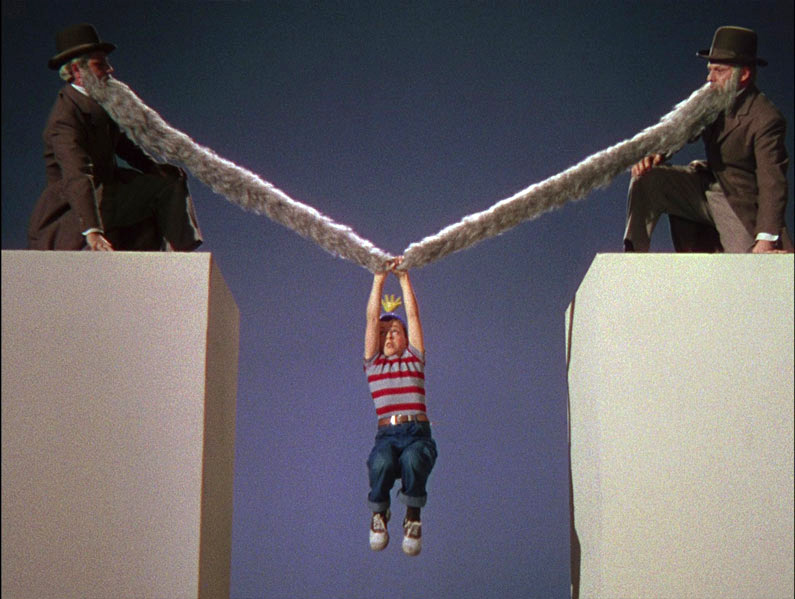
Father Figure (2017): a new interview with Steve Rowland, son of director Roy Rowland (18' 32")
This is a loving trawl through a father's oeuvre by a loving son. Director Rowland seems to be regarded as a journeyman director. To those unfamiliar with that term, it's probably on the derogative side indicating that the director in question can do anything but nothing that would include his or her personal imprint. Hitchcock was no journeyman director. But a son's regard is worth a lot and a stroll through Roy Rowland's career is well worth your time.
Karen Kramer introduction (2007) (2' 11")
This is the always-dependable Karen, Stanley's widow, promoting her husband's work and maintaining his legacy as she did with Guess Who's Coming To Dinner. She tells us that Stanley didn't feel he had enough resources needed to get the film he wanted on screen and no one can argue that Dr. T. wasn't way ahead of its time whatever quality the film aspires to and fails or succeeds to reach. She's a likeable lady perfectly suited to bolster the worthy and diverse Kramer oeuvre. Her piece feels very scripted but hey, what's wrong with that?
Dr. T. on Screen (2007) Cathy Lind Hayes, George Chakiris and others talk about the film (14' 34")
"A very odd, dark and unique movie," says Michael Feinstein and he's right on all three counts. It's nice to see West Side Story's George Chakiris giving his five cents as he is actually in the movie as one of the green skinned musicians. Even in 2007, he looked so damn cool. Composer, Glen Roven shares his Seuss knowledge (I did not know that the UK authorities banned Dr. Seuss books for their subversive nature until the 60s, shame on us). Choreographer Miriam Nelson talks about Eugene Loring, the movie's own strict choreographer and the married leads' daughter Cathy Lind Hayes shares some lovely memories of her childhood.
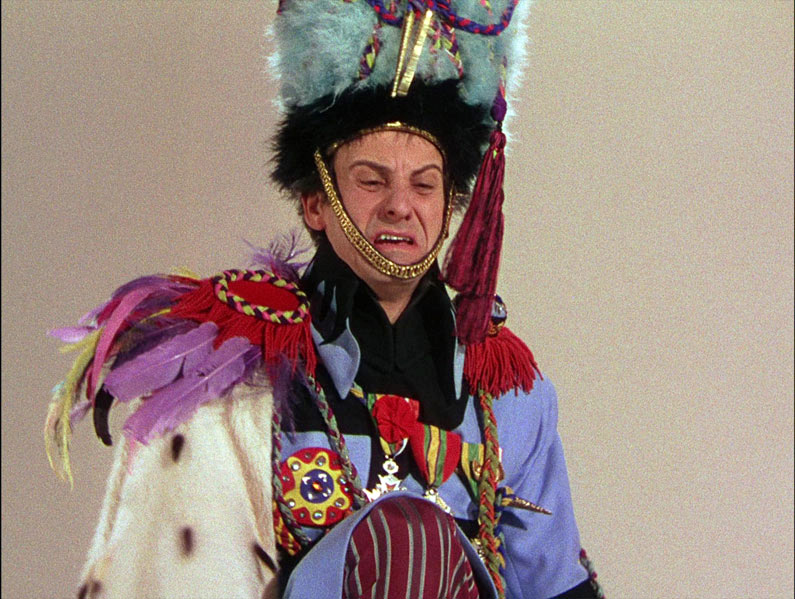
A Little Nightmare Music (2007): an examination of the film's ground-breaking music score (11' 45)
Michael Feinstein takes a more specific look at the score of Dr. T. There's one story repeated from the 'Crazy Music' extra earlier but it was worth repeating. The observation (what is an audio observation, an audiovation?) from Feinstein, who knows his stuff, that many takes of the 'Dressing Song' were stitched together to create the whole is ear-opening (it made me want to scurry back to the excerpt and see if my ears were as sensitive as his). They're not.
Original theatrical trailer (52")
This one's a little odd. It's essentially a cut down of the most 'successful' sequence in the film (the green men playing their home made, makeshift instruments) with optical overlays saying how wonderful it all is. There's no more information and it's more of a teaser as its length implies.
Joe Dante trailer commentary (2013): a short critical appreciation (2' 33")
Genre favourite Joe Dante gives us some info on Dr. T. by looking at the re-issue trailer of the movie fooling no one with a new title (Crazy Music), a release which didn't set the world abuzz either. This is a 'Trailers from Hell' segment. I got the answer to one of my burning questions here and that was that originally, the film had no 'normal' introduction or 'normal' coda and was set completely in the imaginative and unsettling world of Terwilliker's Music Academy (with electrified fencing). I would have paid good money to see the original which must have gone over the two-hour mark with eleven songs snipped out... But then Dr. Seuss's original screenplay was reportedly 1,200 pages (ten times the norm)... The 1,200 Pages of Dr. S. so to speak.
Image gallery: on-set and promotional photography
There's a caption at the top of this collection that states that Columbia pictures embarked on its heaviest still photography campaign for this film. This is hardly surprising as it's a tough sell. Of the 1,610 taken we get 129 here sometimes shown in pairs, all black and white. I know 1,610 seems hardly excessive given today's 'click anything, all the time' mentality but we are talking old 35mm reels (and higher negative formats I imagine) which had about 36 shots a reel which means almost 45 reels. I guess today the average movie stills photographer will produce ten times that amount in the first week of shooting. Adding to this is the newspaper-like marketing, an early example of sly advertising convincing a casual reader that an ad was actually a bona fide news story. We get 29 examples of this covert publicity, and 5 foreign colour posters. Am I the only person who finds the principal human image of the artwork, physically a little off? If Bart really contorted his neck like his artwork avatar does, he'd be dead, wouldn't he? And why is his lettered blue hat, an unlettered red hat? Ah, profound mysteries.
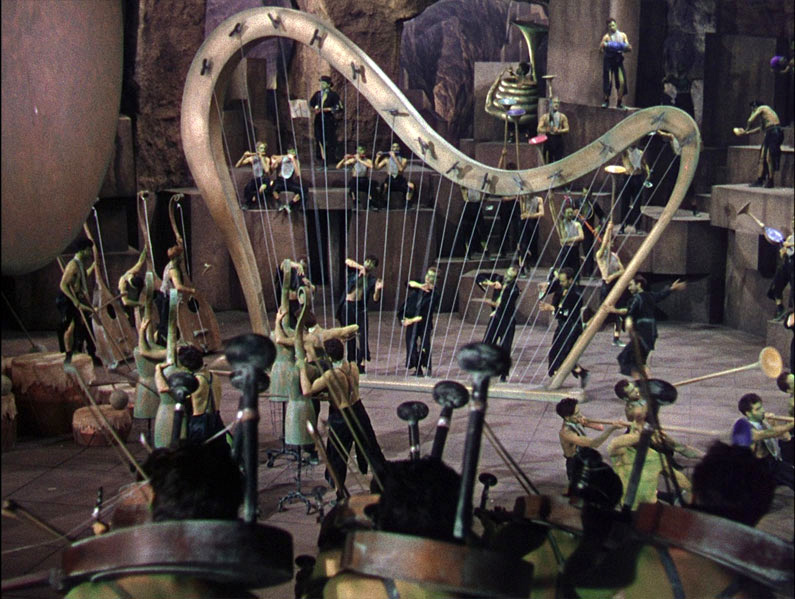
Limited edition exclusive booklet with a new essay by artist Peter Conheim, an overview of contemporary critical responses, and historic articles on the film
This is, as ever, a terrific addition to the whole package. After the cast and crew credits, we are treated to Those Happy Fingers are Yellow and Terrifying by Peter Conheim who charts his relationship with the movie from a Bart-aged viewer in black and white to the shock of the yellow Technicolor, specifically those creepy hands. I've always been a bit of a stickler but I am somewhat surprised that the title The 5,000 Fingers of Dr. T. is often quoted without its comma and its final full stop. Both are present in the actual film's on screen title. The title's even written in several variances in Columbia's own promotional materials. Get a grip, people. The next article, headlined Sights that couldn't be till Nineteen Fifty-Three! is a general article on the movie interspersed with extracts from Columbia's original press book. There is no author credited. The next one, Exploiting the First Musical of the Future takes a closer look at the movie's promotional campaign. The language used in the press pieces is a priceless snap shot of the emerging counter-cultural forces in 50s America. How about this... "When the villain takes their regular instruments away from them, they make their own, give out with a jam session that should be a challenge to every red-blooded hepcat in the country!" Edible language. The article builds upon the previous one in being puzzled why the fame of Dr. Seuss was not exploited more than it was. Lastly, there're extracts from top critics who have recognised the merit in the film and elevated it to cult status. Titled Critical Response: Re-evaluating Dr. T (no full stop... sorry. I'll stop now), the first extract is from the 1954 June Monthly Film Bulletin review by David Robinson. His primary argument, which is valid, is that the film refuses to take a point of view and as such skips all over the place. The other extracts are glowing in praise.
It is said that this movie's scary parts haunted the children who saw it on its original run and subsequently on TV but this extraordinary film has a televisual twin. It specifically reminds me of a fantasy shown on the BBC in the 60s, The Singing Ringing Tree, a DVD of which I've reviewed for this site... Both feature worlds of strangeness, frightening characters and an artistic ambition to be applauded. Both film and TV show's subtle terrors burrowed into the marrow of those young enough for their imaginations to be ever blighted. The 5,000 Fingers of Dr. T. is a one off, a glorious original with eye-popping sets and production design. All its narrative flaws are easily outweighed by its unique nature and visual boldness. Check it out.
|